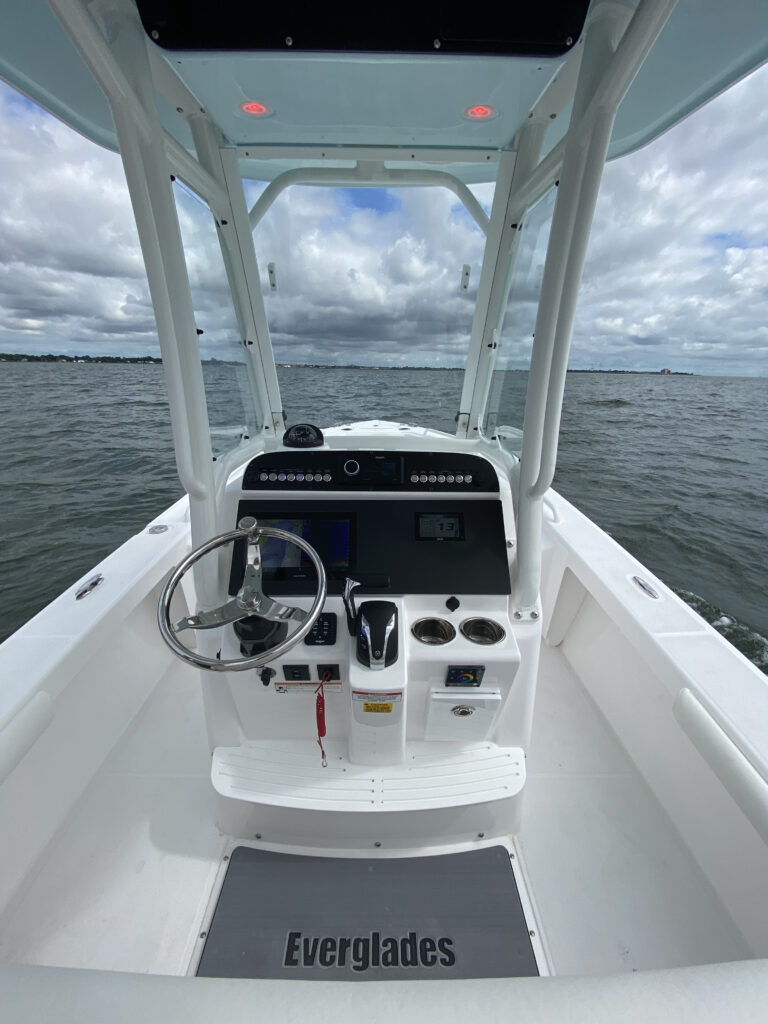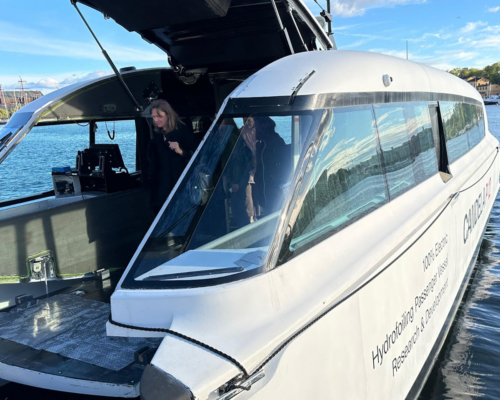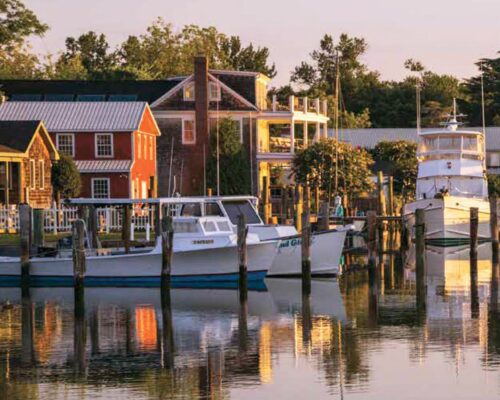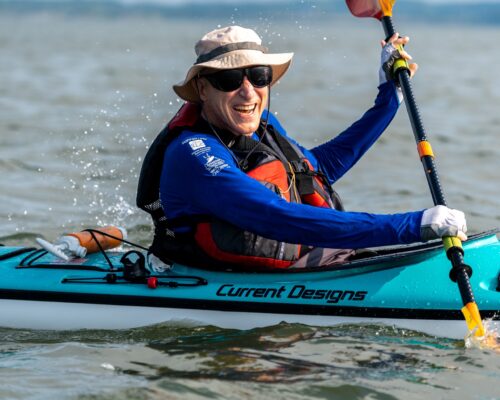It was “kinda sporty” late last fall when Blake Tice of Bluewater Yacht Sales in Hampton took us out into Hampton Roads in a new Everglades 243cc powered by a Yamaha F300 outboard. The 15-knot east wind from the open Atlantic was pushing against a strong ebb current flowing out of the James River. Those conditions made the rig’s manufacturer-certified 43-knot top speed (6000 rpm) irrelevant.
What stood out instead was how happy this rig was in these conditions, running at 17 to 20 knots (3200 to 3500 rpm). The hull eased along over the seas, balanced and firmly on plane, throwing chilly spray out so flat that we and the windshield all stayed dry. The hull felt rock-solid as it sliced through the water, with nary a shake or rattle. The bulletproof Yamaha provided instant response when necessary, especially riding on the backs of following seas.
At one point, we throttled down, put the engine in neutral, and laid her broadside to the seas. The motion was moderate and comfortable. Drift-fishing with jigs or bait would have been comfortable and safe. I began to understand why my friend Frank Bonanno in Baltimore feels comfortable towing his 243cc down to Point Lookout after Thanksgiving to fish the last of Maryland’s rockfish season in the big water off the mouth of the Potomac, or why Capt. Gary Neitzey has fished his 243cc with clients from the Susquehanna Flats in April to the Chesapeake Bay Bridge-Tunnel between the Virginia Capes in December. For prudent skippers, the Everglades 243cc inspires confidence. By the way, Neitzey has been guiding with his boat for 20 years. It was one of the first five 243ccs that Everglades built, and it’s still just as solid as the day he took delivery.
Back in 2003, we had the pleasure of testing one of Gary’s boat’s sisters, hull number 4. This model was arguably the first “hybrid bay boat” that could run shallow inshore but still handle big seas in bluewater offshore. It was the first big-water-capable model the legendary Bob Dougherty designed after he founded Everglades Boats. The hull rides on a variable-deadrise bottom with twin lifting strakes on each side, wide reverse chines, and a pronounced rise in the chine line in the forward quarter. The center of gravity lies right where the skipper and a companion stand or sit at the console.
After all this time, the 243cc remains in the Everglades portfolio, in an age when most boatbuilders retool each model every five to seven years. Curious about why the basic 243cc hull has withstood change, we talked with David Brown, vice president of product development & engineering at Everglades Boats. “It’s the ride and the variable deadrise hull shape,” he explained. “We work constantly to bring our entire portfolio to modern standards, as driven by customer feedback. People run them offshore regularly. We still build 70 to 80 243ccs each year because demand remains strong. This model has great features that endure, starting with the hull. It’s sort of a cult boat.”
He went on to cite the enduring strength of Dougherty’s patented Rapid Molded Construction Process (RAMCAP), in which a pre-molded, high-density foam core fits precisely between an Everglades hull and liner. Using careful monitoring of resin and materials, the lamination crew literally welds the components together with chemical bonds under intense vacuum pressure, after which they allow the boat to cure as one cohesive, rigid, unsinkable boat. The materials for the RAMCAP process have largely remained the same over the life of the 243cc model, because they still meet the specifications of the company’s composite structural engineer. RAMCAP is the foundation for the Everglades lifetime hull warranty. In addition, Everglades builds most components in-house, ensuring that elements like fiberglass parts, aluminum frames and rails, and wiring harnesses meet the company’s high standards.
In addition to RAMCAP construction and the hull form, enduring features of the 243cc include a sturdy but comfortable helm seat that converts readily to a leaning post (we used to joke with Neitzey that the seat was comfortable enough for watching the World Series), a patented up-and-down sliding windshield, multiple rod racks and holders, flip-out tackle bins, a well-designed livewell, convertible seats under the aft casting platform, a convertible bow platform and full hullside bolsters.
At the same time, a lot of new features and equipment have become available since 2003. First of all, the 243cc was designed for Yamaha’s original 225-hp V6, four-stroke outboard, with which it ran well with efficient cruising speeds in the 20s and a top-end around 40 (Neitzey, after some 3,000 hours, replaced his original engine with a super-efficient Yamaha four-cylinder 200.)
Today’s standard engine, though, is the company’s F300, which offers more power on even less fuel, along with Helm Master EX electronic steering and controls, with autopilot and joystick. The original canvas T-top has morphed into a composite hardtop with VHF and storage box, stereo speakers, life jacket storage, rod holders and an elevated ski pylon. The optional fishing package includes a T-and-H Atlas jackplate, an 8-foot Power Pole shallow water anchor and a 36-volt Minn Kota iPilot bow mount trolling motor. For sight-fishing, a full upper steering station is available with controls and electronics. One interesting option is a pair of transom lifting platforms that are built separately, foam-filled, and bolted on for added buoyancy, shallow draft, and lift, plus providing a base for a PowerPole. Everglades fits the 243cc’s trim tabs into pockets molded underneath.

Brown told us that he and his staff evaluate every Everglades model each year for upgrades to keep the boat competitive. Examples include switches, lighted stereo speakers, SeaDek nonskid pads and Garmin electronics upgrades. A naval architect on staff reviews all changes to make sure they don’t affect the boat’s balance or performance. The engineering department also monitors updates to the systems standards promulgated by the American Boat & Yacht Council (ABYC) and the National Marine Manufacturers Association (NMMA). For example, the three 12-volt trolling motor batteries fit into a bow compartment on mounts that must pass an ABYC pull test. The option of lithium-iron-phosphate batteries will be available soon.
No, the Everglades 243cc does not have hinged backs that convert bow seats into forward-facing lounges, and headroom inside the console is only 41 inches, so it’s not a practical space for anyone but children to use the available portable toilet, but boaters have gotten by without such amenities for centuries. The 243cc is still a comfortable boat for many family activities, and its new features make it an even better, more versatile rig that fits virtually any fishery in the Chesapeake. Most of all, though, it remains a safe, seaworthy rig, an investment whose working lifespan can be measured in generations rather than years. It endures because it works, a testimony to Bob Dougherty’s hard-won design wisdom: “It takes complex thinking and planning to make something simple.”
Base price for a 2023 Everglades 243cc with a Yamaha F300 is $167,327. Our test boat, with Garmin electronics, a stereo, and a modest set of options, freight, make-ready features and a safety package carried a retail price of $196,147.
Editor-at-Large John Page Williams is a fishing guide, educator, author and naturalist, saving the Bay since 1973.
Everglades 243cc
LOA: 24’3″
Beam: 8’2″
Draft: 16/31” (engine up/down)
Weight: 4,120 lb. (dry, w/o engine)
Weight: 5,650 lb. (full fluids, engine, options)
Transom Deadrise: 19 degrees Transom Height: 30″
Bridge Clearance: 7’5” (to hardtop)
Bridge Clearance: 8’8” (w/ upper station)
Fuel Cap: 82 gal
Water Cap: 9 gal
Livewell Capacity: 36 gal Max Power: 300 hp
For more information, visit www.evergladesboats.com/sportfish/bay-boats/243cc/.
Everglades dealers in the Chesapeake are Bluewater Yacht Sales in Hampton, Virginia, and Annapolis Boat Sales in Chester, Maryland.




